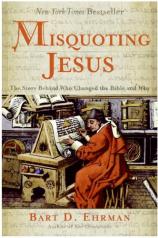Misquoting Jesus
Review
Misquoting Jesus
In recent years, Bart D. Ehrman has made a reputation for himself as an accomplished history and religion scholar who is able to write reader-friendly books for non-academic audiences without dumbing down the content. In 2003, it was LOST CHRISTIANITIES, a look at the diversity of belief that flourished in the first centuries after Christ. Last year, it was TRUTH AND FICTION IN THE DA VINCI CODE, in which he pointed out the historical flaws in Dan Brown's novel. This time around, it's the New Testament --- specifically, from the perspective of a textual critic.
Simply put, textual criticism is the attempt to restore the wording of a manuscript whose original no longer exists. For New Testament scholars, that means taking the various fragments and manuscripts that do exist --- none dating before the fourth century --- and recreating the text as closely as possible to whatever the original version may have been or, perhaps better, to discover the best possible version. As Ehrman points out, that's a monumental undertaking, given the many discrepancies between the manuscripts and fragments that have survived.
Throughout the book --- which was originally titled THE MONK AND THE MESSIAH --- Ehrman explains why so many discrepancies appear in what Christians consider to be the Word of God. Some are innocent enough: fatigue, a mishearing or misreading on the part of the scribe or the monk, and the not-so-minor problem created by a form of writing that included no punctuation and no spaces between words. Others, though, are more problematic: a monk forced to choose between two distinctly different meanings for the same word would likely be inclined to choose the meaning that best represented his own beliefs. Still others were blatant errors or additions that were introduced to alter the meaning of the text. Ehrman offers clear and compelling examples of each kind of error, enough that even a skeptical reader would be hard-pressed to argue that what we have today is what was written in the first century.
One amusing graphic is a reproduction of a page from a fourth-century manuscript in which one scribe wrote this in the margin, apparently blasting a previous copyist: "Fool and knave, leave the old reading, don't change it!" It's amusing, that is, until you consider the many battles Christians have fought with each other over the accuracy of the biblical text.
So many are the discrepancies that Ehrman states bluntly, "There are more differences among our manuscripts than there are words in the New Testament." Scholars have estimated that there are between 30,000 and 400,000 differences in the text --- a wide range, for sure, but that just shows how complex the field of textual criticism is.
One of the most fascinating insights Ehrman offers is an explanation of the literacy rates at the time of Christ and later, particularly what it meant to be "literate" --- which sometimes meant little more than the ability to copy words. Yet, before the rise of monasticism, it often fell to a "literate" Christian in a given town to copy the gospels or the letters of Paul or other letters and writings of New Testament authors. The potential for error was great, and that did not go unnoticed either within the church or without. Origen, a third-century church father, complained about the many mistakes he had found, while a pagan critic of Christianity wrote that Christian scribes had done their work "as though from a drinking bout." Good reading, this book of Ehrman's.
Despite all my praise for MISQUOTING JESUS, I confess I had a tough time reading past page 13, for what may seem to some readers to be an insignificant reason. But there, right on the page, Ehrman refers to the "Timothy LeHaye and Philip Jenkins series Left Behind." Do I need to point out all the errors in those few words? One, it's LaHaye, not LeHaye. Two, I'm guessing no one's called him Timothy since his baptismal certificate was signed; he's been known as Tim for at least the nearly 40 years he's been a published author. Three, Philip Jenkins? Philip Jenkins? I have to believe that a scholar of Ehrman's stature, a professor who pores over ancient manuscripts with exactitude and precision and accuracy, is not the one who made that mistake; I'm going to assume it was a well-meaning editor. Philip Jenkins is a religion professor at Penn State, and I'm sure Ehrman is well-acquainted with his work. LaHaye's co-author is Jerry Jenkins, not Philip. Oh, and "Timothy" was given the last name of LaHay on page 110, but in the index, it was back to LeHaye. Should I even mention that Hal Lindsey's name was spelled "Lindsay" in that same sentence on page 110?
Maybe those mistakes are intentional. Maybe the editor, or Ehrman himself, was winking at us by underscoring the various ways errors can creep in to a manuscript. Somehow, I think that's not the case. Ironic that an Editing 101 error --- getting the names right --- should appear in a book on misquoting Jesus.
Those errors aside, Ehrman has done an exceptional job of translating complex findings by New Testament scholars not only into language we can understand but also into an absorbing narrative. I'm already looking forward to his next release --- the intriguingly titled PETER, PAUL, AND MARY --- in May.
Reviewed by Marcia Ford on November 1, 2005




